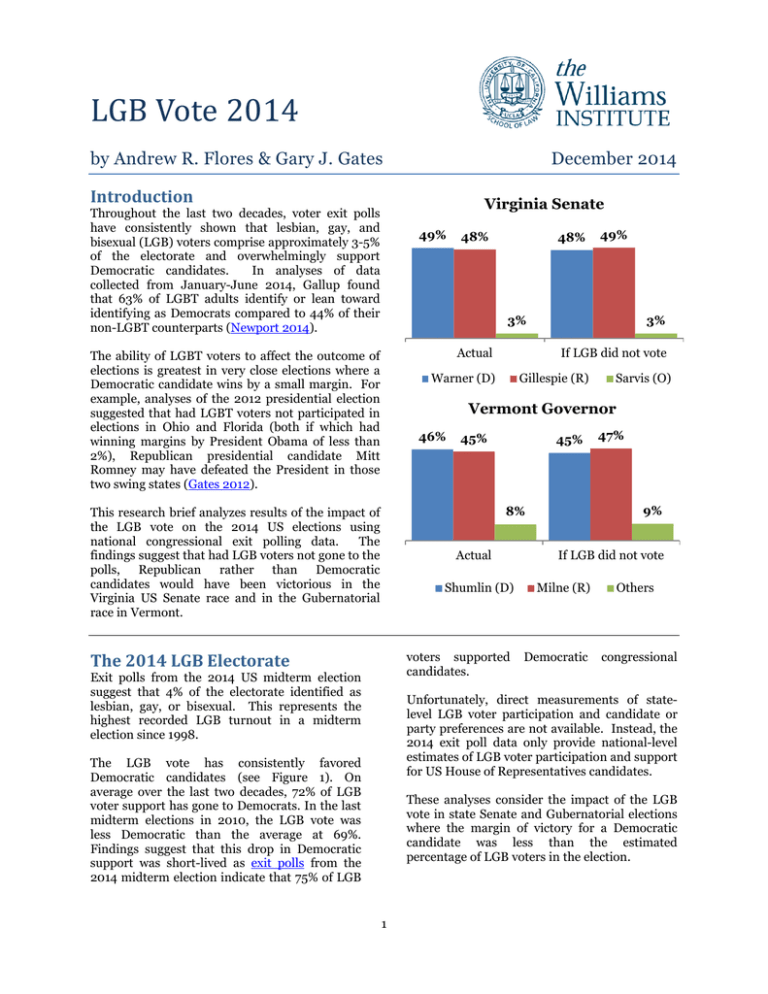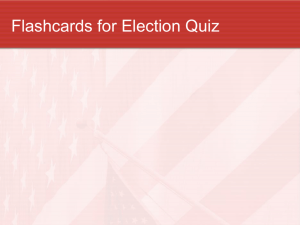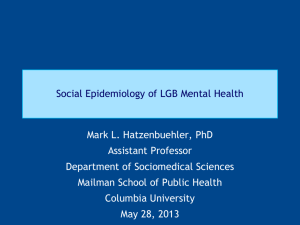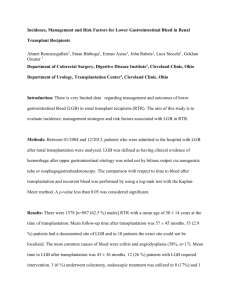
LGB Vote 2014
by Andrew R. Flores & Gary J. Gates
December 2014
Introduction
Virginia Senate
Throughout the last two decades, voter exit polls
have consistently shown that lesbian, gay, and
bisexual (LGB) voters comprise approximately 3-5%
of the electorate and overwhelmingly support
Democratic candidates.
In analyses of data
collected from January-June 2014, Gallup found
that 63% of LGBT adults identify or lean toward
identifying as Democrats compared to 44% of their
non-LGBT counterparts (Newport 2014).
49%
48%
48%
49%
3%
3%
Actual
The ability of LGBT voters to affect the outcome of
elections is greatest in very close elections where a
Democratic candidate wins by a small margin. For
example, analyses of the 2012 presidential election
suggested that had LGBT voters not participated in
elections in Ohio and Florida (both if which had
winning margins by President Obama of less than
2%), Republican presidential candidate Mitt
Romney may have defeated the President in those
two swing states (Gates 2012).
If LGB did not vote
Warner (D)
Gillespie (R)
Sarvis (O)
Vermont Governor
46%
45%
45%
9%
8%
This research brief analyzes results of the impact of
the LGB vote on the 2014 US elections using
national congressional exit polling data.
The
findings suggest that had LGB voters not gone to the
polls, Republican rather than Democratic
candidates would have been victorious in the
Virginia US Senate race and in the Gubernatorial
race in Vermont.
Actual
The 2014 LGB Electorate
Exit polls from the 2014 US midterm election
suggest that 4% of the electorate identified as
lesbian, gay, or bisexual. This represents the
highest recorded LGB turnout in a midterm
election since 1998.
47%
If LGB did not vote
Shumlin (D)
Milne (R)
voters supported
candidates.
Democratic
Others
congressional
Unfortunately, direct measurements of statelevel LGB voter participation and candidate or
party preferences are not available. Instead, the
2014 exit poll data only provide national-level
estimates of LGB voter participation and support
for US House of Representatives candidates.
The LGB vote has consistently favored
Democratic candidates (see Figure 1). On
average over the last two decades, 72% of LGB
voter support has gone to Democrats. In the last
midterm elections in 2010, the LGB vote was
less Democratic than the average at 69%.
Findings suggest that this drop in Democratic
support was short-lived as exit polls from the
2014 midterm election indicate that 75% of LGB
These analyses consider the impact of the LGB
vote in state Senate and Gubernatorial elections
where the margin of victory for a Democratic
candidate was less than the estimated
percentage of LGB voters in the election.
1
Figure 1. LGB vote for Democratic
candidates & %LGB voters,
1996-2014.
70%
75% 75%
80%
69%
65% 64%
(75% Democrat, 24% Republican, 1% Other) for
the LGB vote is the same across the states and in
both Senate and Gubernatorial races.
The
portion of LGB voters is varied across states
based on an adjustment using data from Gallup
that estimates the portion of adults who identify
as LGBT in each state.
76% 75%
LGB votes are effectively removed from final
tallies to assess if the outcome of particular races
would change if LGB voters had not participated
in the election. Details of the methodology are
described in the Appendix.
The LGB Vote in the Senate Races
5%
4%
4%
4%
3%
4%
3%
5%
Exit polls suggest that LGB individuals comprise
a relatively small proportion of the national
electorate. As a result, very close elections
where margins between winning and losing
candidates are less than the total number of LGB
voters constitute races where the LGB vote can
plausibly affect the outcome of a race.
4%
1996 1998 2000 2004 2006 2008 2010 2012 2014
LGB vote
%LGB voters
These analyses consider the three races for US
Senate that had the closest vote margins
between the two leading candidates: Virginia,
New Hampshire, and Louisiana (see Table 1).
Among Senate races, Democratic candidates in
New Hampshire and Virginia won by margins
that were less than the estimated percentage of
LGB voters in those states. The difference
between the two top candidates in the Louisiana
Senate race was also less than the percentage of
LGB voters, though the Louisiana election will
ultimately be decided in a runoff between the
top two candidates.
The election was unexpectedly close in Virginia,
with the Democratic incumbent Mark Warner
winning narrowly over Republican Ed Gillespie
by a margin of less than 1% of all votes cast.
Analyses suggest that, without LGB votes heavily
favoring Warner, Gillespie would have won by a
margin of 1.3% (49.4% to 48.1%). The Virginia
Senate seat would have gone to the Republican
rather than the Democratic candidate.
Among
Gubernatorial
races,
Democratic
candidates in Colorado, Connecticut, and
Vermont all won with margins of victory that
were less than the percentage of LGB voters.
Louisiana’s top two candidates will enter a runoff since neither the Democratic incumbent,
The analyses assume that the partisan
breakdown in the national midterm exit poll
Table 1. Senate election results and estimates if the LGB population had not voted.
Virginia
Louisiana
New Hampshire
% LGB
voters
3.5%
3.9%
3.7%
Margin
of Dem
victory
0.8%
1.1%
3.2%
If LGB had not voted
Actual vote
Democrat
49.2%
42.1%
51.6%
Republican
48.4%
41.0%
48.4%
2
Other
2.5%
16.9%
0.0%
Democrat
48.1%
40.9%
50.5%
Republican
49.4%
41.8%
49.5%
Other
2.5%
17.2%
0.0%
Mary Landrieu, nor her Republican challenger,
Bill Cassidy, received a majority of the vote. As a
result, these analyses do not consider if the LGB
vote affected who actually takes the Senate seat
from Louisiana, but rather the ordering of the
two candidates.
The election in Vermont proved narrow with
Democratic incumbent Governor Peter Shumlin
reelected by a margin of 1.1% against Republican
challenger Scott Milne. Analyses suggest that
without the strongly Democratic LGB vote in
Vermont, the election would have favored the
Republican challenger by a margin of 2.3%.
In that race, Landrieu garnered 1.1% more of the
votes than Cassidy. However, without LGB
voters in the race, Cassidy would have garnered
an estimated 1.1% more votes than Landrieu.
In
Connecticut,
Democratic
incumbent
Governor Dan Malloy won the election over
Republican challenger Tom Foley by a thin 2.8%
margin. Without the LGB vote, analyses suggest
that the margin of victory for the Democratic
incumbent would have narrowed to just 0.3%,
which would have made the election much closer
and potentially subject to a recount.
New Hampshire was also a closely watched race
where Democratic incumbent Senator Jeanne
Shaheen defeated former Republican US Senator
from Massachusetts, Scott Brown, by a narrow
3.2% margin.
Colorado’s
Democratic
incumbent
John
Hickenlooper was challenged by Republican Bob
Beauprez and won by a 2.9% margin. In the
absence of LGB voters, estimates suggest that
margin would have been only 0.4%, again
suggesting the possibility of a recount.
Analyses suggest that the results would have
been considerably closer if LGB individuals had
not voted. Shaheen’s margin of victory would
have been an estimated 1%. If LGB voters had
not participated in the election in Vermont, it is
possible that it would have been close enough to
trigger a recount.
Conclusion
The findings suggest that the strong support for
Democratic candidates among LGB voters was
enough to alter the results of the Virginia Senate
race, change the ordering of top candidates in
the Louisiana race, and make the New
Hampshire Senate race possibly too close to call.
Much of the post-election analyses focused on
the wave of Republican wins in the US Senate,
US House, and many state Governor races.
These analyses suggest that in states where the
vote was very close, the LGB vote played a
pivotal role.
LGB voters generally comprise about 4% of the
electorate and consistently and overwhelmingly
support Democratic candidates. Their presence,
though a small portion of the population, makes
their vote highly consequential in close races.
For the 2014 races, the analyses suggest that the
LGB vote may have altered the outcomes of the
Senate
election
in
Virginia
and
the
Gubernatorial race in Vermont.
The LGB vote in the
Gubernatorial Races
Gubernatorial
elections
in
Vermont,
Connecticut, and Colorado were all close enough
that the LGB vote may have been decisive in the
outcome (see Table 2).
Table 2. Gubenatorial election results and estimates if the LGB population had not voted.
Vermont
Connecticut
Colorado
% LGB
voters
6.0%
4.1%
4.2%
Margin
of Dem
victory
1.1%
2.8%
2.9%
Actual vote
Democrat
46.4%
50.9%
49.1%
Republican
45.3%
48.1%
46.2%
3
If LGB had not voted
Other
8.3%
1.0%
4.7%
Democrat
44.6%
49.6%
47.8%
Republican
46.9%
49.3%
47.4%
Other
8.6%
1.0%
4.8%
Appendix: Methodology
The ideal way to derive the impact of the LGBT vote on any particular race would be to randomly survey
voters in each race and ask them who they voted for along with their sexual orientation and gender
identity. While the national voter exit polling asks voter candidate preferences along with their sexual
orientation (though not gender identity), it only produces national estimates of the LGB vote.
The analyses in this research brief use a common statistical procedure known as Bayes Rule to derive an
estimate of the outcome of the election if only non-LGB individuals had voted. The procedure requires
two assumptions:
• The size of the LGB electorate in any state is proportionate to the national LGB turnout (4%)
relative to proportion of LGBT adults in each state. The latter proportion is derived using data
from Gallup’s Daily Tracking Survey collected from 2012-2014. Analyses from those data
estimate that 3.9% of adults in the US identify as LGBT. Assume, for example, that the Gallup
data found that 4.5% of adults identified as LGBT in state X. Relative to the Gallup national
LGBT estimate, the proportion of LGBT adults in state X is 1.15 times higher than the national
average (4.5%/3.9%). These analyses derive an estimate if the proportion of LGB voters in that
state as 1.15 x 4% (the national average of the proportion LGB among voters), or 4.6%.
• The national estimate for LGB party voting in the US House is equal in every state and reflects
candidate preferences in Senatorial and Gubernatorial elections.
Assumption 1 provides the proportion of LGB and non-LGB voters by state, or put differently, the
probability that voters in a particular election are LGB or non-LGB, represented as Pr(LGB) and
Pr(Non-LGB), respectively.
The exit poll data is used to derive the portion of LGB or non-LGB votes that go to a particular candidate.
These figures are the probability that an individual voted for a particular candidate (in this example, the
Republican) given that they are either LGB or non-LGB. This is represented as Pr(𝑅𝑅|LGB) and
Pr(𝑅𝑅|Non-LGB). The analyses use exit poll estimates for Republican, Democratic, and Other candidates
(combined into a single estimate if there were multiple third-party candidates).
The next step in the analyses derives the proportion of LGB and non-LGB voters among voters for each
candidate. Again, using the Republican candidate as an example, this is represented as the probability
that a voter is LGB or non-LGB given that the voter supported the Republican candidate, represented as
Pr(LGB|R) and Pr(non − LGB|𝑅𝑅). These estimates are derived using Bayes Rule as follows:
Pr(non-LGB|𝑅𝑅) =
Pr(non-LGB) ∗ Pr(𝑅𝑅|non-LGB)
Pr(non-LGB) ∗ Pr(𝑅𝑅|non-LGB) + Pr(LGBT) ∗ Pr(𝑅𝑅|LGBT)
Pr(LGB|𝑅𝑅) = 1 − Pr(non-LGB|𝑅𝑅)
The example above shows the calculations used to derive the proportion of LGB and non-LGB voters
among Republican voters. This procedure is also used to derive the same proportions among Democratic
voters and among those who supported third-party candidates.
The last step in the analytical procedures is to estimate the vote if LGB voters had not voted in the
election. This is the probability that a voter supported each candidate given that the voter was non-LGB,
represented as Pr(𝑅𝑅𝑅𝑅|non-LGB) in the case of a Republican candidate. Using Bayes Rule, this estimate is
derived as:
Pr(𝑅𝑅𝑅𝑅|non-LGB) =
Pr(𝑅𝑅𝑅𝑅) ∗ Pr(non-LGB|𝑅𝑅)
Pr(𝑅𝑅𝑅𝑅) ∗ Pr(non-LGB|𝑅𝑅) + Pr(𝐷𝐷𝐷𝐷) ∗ Pr(non-LGB|𝐷𝐷𝐷𝐷) + Pr(𝑂𝑂𝑂𝑂) ∗ Pr(non-LGB|𝑂𝑂𝑂𝑂)
Where Pr(𝑅𝑅𝑅𝑅), Pr(𝐷𝐷𝐷𝐷), and Pr(𝑂𝑂𝑂𝑂) represent the total vote in a given election for the Republican,
Democratic, and Other candidates, respectively. Applying this equation to each party derives the
4
estimates for the non-LGB vote (or the vote if LGB voters had not participated in the election) for each
candidate.
About the authors
Andrew R. Flores is Public Opinion Project Director at the Williams Institute and Ph.D candidate in
Political Science at the University of California at Riverside.
Gary J. Gates, PhD is the Blachford-Cooper Distinguished Scholar and Research Director at the Williams
Institute. He is a national expert in the demographic, geographic, and economic characteristics of the
LGBT population.
About the institute
The Williams Institute on Sexual Orientation and Gender Identity Law and Public Policy at UCLA
School of Law advances law and public policy through rigorous, independent research and scholarship,
and disseminates its work through a variety of education programs and media to judges, legislators,
lawyers, other policymakers, and the public. These studies can be accessed at the Williams Institute
website.
For more information:
The Williams Institute, UCLA School of Law
Box 951476
Los Angeles, CA 90095-1476
(310) 267-4382
williamsinstitute@law.ucla.edu
http://williamsinstitute.law.ucla.edu
5







